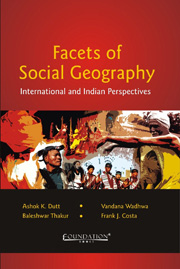Book contents
- Frontmatter
- Contents
- Foreword
- Preface
- Acknowledgements
- List of Contributors
- I Introductory Framework: Allen G. Noble's Contribution to Social Geography
- II Conceptual and Theoretical Basis of Social Geography
- III Social Geography from a Global Perspective
- IV Social Geography in the Indian Context
- 15 Socio-cultural Regions in Pre-historic and Historic India
- 16 Distinct Regional Cultural Identities of India Based on Religion and Language
- 17 Linguistic Diversity Changes in India: A Regional Analysis, 1971–2001
- 18 The Geography of Folk Art in India
- 19 Indian Dance: Classical Unity and Regional Variation
- 20 Space, Gender and Social Value: Analyzing Gender Inequalities in Relation to Space
- 21 Encountering Reservation and the Reimagining of Caste
- 22 Spatial Patterns of Crime in India
- 23 Rural Human Resource Development in India: A Spatio-Temporal Analysis
- V Indian Social Geography: City and State Context
- Index
22 - Spatial Patterns of Crime in India
from IV - Social Geography in the Indian Context
Published online by Cambridge University Press: 05 June 2012
- Frontmatter
- Contents
- Foreword
- Preface
- Acknowledgements
- List of Contributors
- I Introductory Framework: Allen G. Noble's Contribution to Social Geography
- II Conceptual and Theoretical Basis of Social Geography
- III Social Geography from a Global Perspective
- IV Social Geography in the Indian Context
- 15 Socio-cultural Regions in Pre-historic and Historic India
- 16 Distinct Regional Cultural Identities of India Based on Religion and Language
- 17 Linguistic Diversity Changes in India: A Regional Analysis, 1971–2001
- 18 The Geography of Folk Art in India
- 19 Indian Dance: Classical Unity and Regional Variation
- 20 Space, Gender and Social Value: Analyzing Gender Inequalities in Relation to Space
- 21 Encountering Reservation and the Reimagining of Caste
- 22 Spatial Patterns of Crime in India
- 23 Rural Human Resource Development in India: A Spatio-Temporal Analysis
- V Indian Social Geography: City and State Context
- Index
Summary
No one is a born criminal; even if someone has the questionable ‘crime-related gene’, it is primarily one's environment and experiences that induce criminal conduct. Cruel and loveless upbringing, social and economic deprivation, a physically dilapidated and gang-infested neighborhood, hostile atmosphere in the house, crimeridden historic traditions and suffocating population densities are some environmental conditions that contribute to the initiation and continuation of criminal activities (Dutt, Noble and Singh, 1979). Geographers first started to unravel the geography of crime in the 1970s. There were others who contributed to the study of spatial aspects of crime (Pyle et al., 1974). In India, both criminologists and sociologists have researched different aspects of crime (Rao, 1981), but spatially-oriented crime studies started to appear only in the 1970s. Nayar (1975) provided a nationwide spatial analysis of crime. Indian crime studies with this spatial component followed from the 1970s through the earlier part of the twenty-first century. These studies may be grouped into three levels – city (micro), regional (meso) and national (macro). They have been reviewed here followed by an analysis of the relationship between crime and politics.
Review of City Scale Studies
The city has often been thought to be a good breeding ground for crime; possibly due to the contributing factors of anomie, congestion, heterogeneity, cultural and traditional breakdowns resulting from the processes of urbanization and industrialization; but also possibly because crime in rural areas is largely underreported.
- Type
- Chapter
- Information
- Facets of Social GeographyInternational and Indian Perspectives, pp. 416 - 436Publisher: Foundation BooksPrint publication year: 2012



